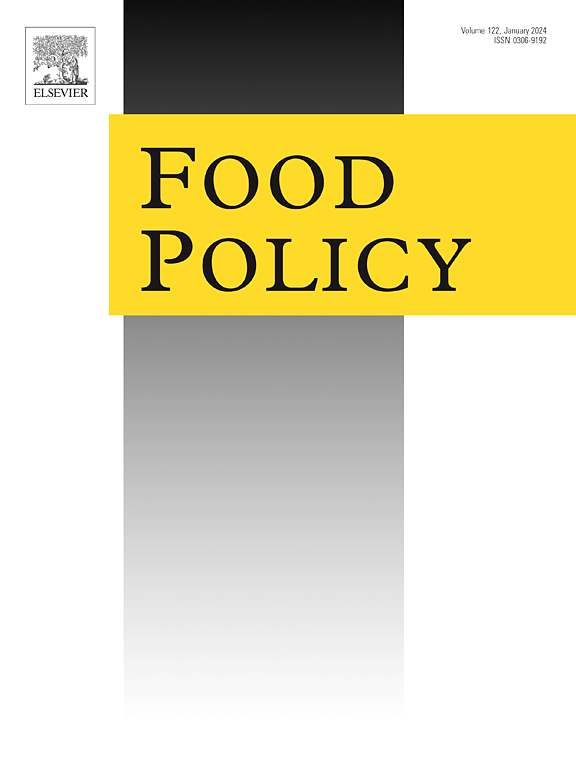Maize yield responsiveness and profitability of fertilizer: New survey evidence from six African countries
IF 6
1区 经济学
Q1 AGRICULTURAL ECONOMICS & POLICY
引用次数: 0
Abstract
Enhancing maize productivity growth is pivotal for revolutionizing the agrifood system in Africa, with inorganic fertilizer serving as a fundamental input for catalyzing this progress. However, concerns are mounting about the low and decreasing yield response and profitability of inorganic fertilizer use, particularly in Sub-Saharan Africa. This study aims to refine yield response and profitability models by incorporating recent data from nationally representative and panel datasets spanning six countries. Most countries exhibited low nitrogen yield responsiveness (4–7 kg), while Ghana and Uganda showed higher responsiveness (15–20 kg) per additional 1 kg of nitrogen. Analysis of fertilizer-to-maize price ratios from 2010 to 2023 showed a downward trend, with spikes in 2022 in Ghana, Malawi, Nigeria, and Tanzania. Overall, except for those years, the data suggest a trend of increasingly favorable price incentives for fertilizer use. Ethiopia, Tanzania, and Uganda experienced declines in the fertilizer-to-maize price ratio. Increasing inorganic fertilizer use would be profitable in Ethiopia, Ghana, Nigeria, and Uganda at current market prices, but not in Malawi or Tanzania. Subsidies in Malawi and Tanzania have boosted profitability, but these may not be necessary in Ghana, Nigeria, or Uganda, which already have favorable price incentives; Malawi could benefit by substantially reducing its 80 percent subsidy while maintaining decent price incentives and farm profits. The paper proposes policy options based on factors influencing yield responsiveness and potential improvements drawn from new modeling and synthesis of the literature.
玉米产量对肥料的响应性和盈利能力:来自六个非洲国家的新调查证据
提高玉米生产力对于非洲农业粮食系统的变革至关重要,无机肥料是促进这一进步的基本投入。然而,人们越来越关注无机肥料使用的低产量反应和盈利能力,特别是在撒哈拉以南非洲。本研究旨在通过整合来自六个国家的具有全国代表性和面板数据集的最新数据来完善产量响应和盈利模型。大多数国家表现出较低的氮产量响应性(4-7公斤),而加纳和乌干达每增加1公斤氮就表现出较高的响应性(15-20公斤)。对2010年至2023年化肥与玉米价格比率的分析显示出下降趋势,加纳、马拉维、尼日利亚和坦桑尼亚在2022年出现峰值。总的来说,除了那些年,数据表明化肥使用的价格激励有越来越有利的趋势。埃塞俄比亚、坦桑尼亚和乌干达的肥料与玉米的价格比有所下降。按照目前的市场价格,增加无机肥料的使用在埃塞俄比亚、加纳、尼日利亚和乌干达是有利可图的,但在马拉维或坦桑尼亚则不然。马拉维和坦桑尼亚的补贴提高了盈利能力,但在加纳、尼日利亚或乌干达可能没有必要,因为这些国家已经有优惠的价格激励措施;马拉维可以通过大幅减少其80%的补贴而受益,同时保持适当的价格激励和农业利润。本文根据影响产量响应性的因素和从新的建模和文献综合中得出的潜在改进提出了政策选择。
本文章由计算机程序翻译,如有差异,请以英文原文为准。
求助全文
约1分钟内获得全文
求助全文
来源期刊

Food Policy
管理科学-农业经济与政策
CiteScore
11.40
自引率
4.60%
发文量
128
审稿时长
62 days
期刊介绍:
Food Policy is a multidisciplinary journal publishing original research and novel evidence on issues in the formulation, implementation, and evaluation of policies for the food sector in developing, transition, and advanced economies.
Our main focus is on the economic and social aspect of food policy, and we prioritize empirical studies informing international food policy debates. Provided that articles make a clear and explicit contribution to food policy debates of international interest, we consider papers from any of the social sciences. Papers from other disciplines (e.g., law) will be considered only if they provide a key policy contribution, and are written in a style which is accessible to a social science readership.
 求助内容:
求助内容: 应助结果提醒方式:
应助结果提醒方式:


